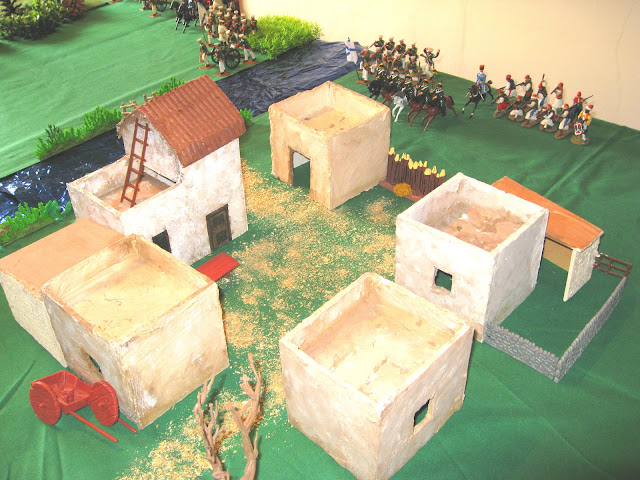Following on from the Herring War game a few weeks back (see earlier post) AM and I made tentative arrangements to meet again across the table of Mars, AM chose the period, Medieval, so I got to choose the rules. I was a little surprised at the choice, but pleasantly so as I'd been spending a little too much hobby time working on the 17th and 19th centuries recently and a change is as good as a rest etc.
The lay of the land at the start of the game. The flower of French chivalry confidently line the southern hills on the left while the bawdy English and their brutish allies the Burgundians are jostled into line along the northern slopes opposite, between them the marshes in the valley floor are swollen from the incessant rains
I mentioned in a previous post
here that I had stumbled across the first set of wargame rules written by Tony Bath, founder of the Society of Ancients, in 1956 and since then I have been looking for an opportunity to try them out.
The English lights - cavalry and infantry rush into the fray
There's something that appeals to me about the idea of using old rules for playing with old toy soldiers. Now, my medievals don't hail from 1956, they're mostly from the 1960's, (well, some are) so not too far out. When I first read the rules I assumed they were written for 54mm soldiers because the movement distances were what I would expect for larger size figures and of course that was the type most widely available back then. Also there was something about the game mechanisms that reminded me very much of Wells' Little Wars rules.
The well appointed French heavies - cavalry, infantry and swarms of crossbowmen begin a ponderous advance over difficult ground
Tony Bath actually used 30mm flat zinnfiguren which he imported from Germany for his games as the Ancient and Medieval periods were barely covered by the toy manufacturers of the day and this was long before the advent of the 20mm wargame miniature or even that pillar of the hobby soon to be known as Airfix. By contrast the historical coverage of the flat manufacturers was, and remains, phenomenal.
Faced with the prospect of a charge from the heavy French horsemen, the English infantry make for the relative safety of the marshlands
Although the name of Tony Bath has become synonymous with the Ancient period it was to be several years after writing these rules that he founded the Society of Ancients and it is clear (apart from the title) that he intended them to stretch to cover at least the Hundred Years War as there is specific provision for "dismounted cavalry in full armour armed with shortened lance as used by the french at Poitiers".
The French crossbowmen have secured the ruined abbey
So, very much an old school game was had, with books under sheets for hills, pine cones for bushes, marshes hastily cut for the occasion from card and aquarium ornaments for ruins. The Anglo-Burgundian force were mostly Timpo swappets with a hindrance of militia provided by Elastolin Saxons and stiffened by a phalanx of Deetail pikemen. The French were mostly conversions, some painted in heraldic livery and finished in the toy style.
First blood to the French, the heavy cavalry on their right charges into the first line of Burgundian men at arms while a body of militia forms a hedge of pikes to protect themselves from the onslaught
We wanted to play the game as true as we could to the original rules without any tweaks and we could see that they depend on testing combat strength v mobility between the various differing classes of troops, so to give them a good first run out we made the opposing armies very different in composition. The French were much heavier with greater firepower, about 30 heavy cavalry, 30 heavy infantry and 30 archers. The Allies were much lighter but greater in number: 15 light cavalry, 60 light infantry, 10 militia, 10 heavy infantry and 10 archers.
On the French left more heavy cavalry approach the marshes but are checked and look for firmer ground through them
I was given permission by the British Model Soldier Society to reproduce these rules for enthusiasts but before I got around to doing it I discovered they had been published as part of the History of Wargaming project, edited by John Curry, in Vol 4 -
More Wargaming Pioneers so if you want to give this game a spin I would urge you to buy the book, it costs less than £12 and is part of a project that deserves all our support. What I have done is produce a summary of the rules in a quick reference sheet which I will make available in the next post, but you really should still buy the book because there's a lot more in it.
The English men at arms jeer at the French knights from the relative safety of the wetlands egging them on to come forward





























































